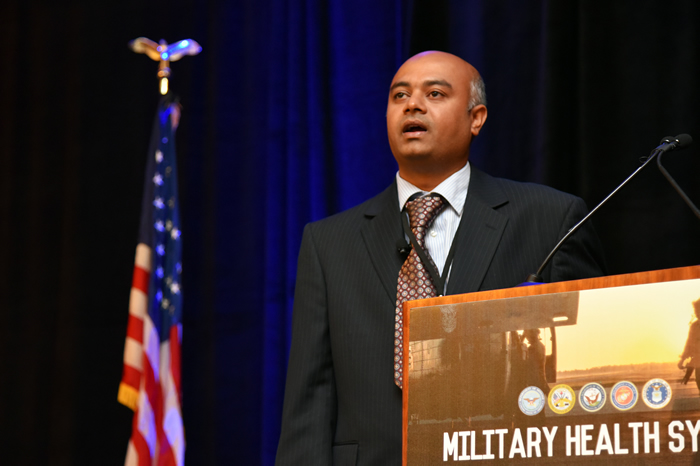Army Medicine research scientists working to eliminate heat-related injuries

A team of research scientists at the Department of Defense Biotechnology High Performance Computing Software Applications Institute, Telemedicine and Advanced Technology Research Center, U.S. Army Medical Research and Materiel Command at Fort Detrick, Maryland, are working to eliminate heat-related injuries to military service members.
According to Srinivas Laxminarayan, Ph.D., a research scientist at the DOD BHSAI, every year there are more than 2,000 cases of heat injuries in the military. "Surprisingly, 93 percent of those cases are from non-combat operations," he said.
Laxminarayan presented the information of their study at the 2015 Military Health System Research Symposium in Fort Lauderdale, Florida, Aug. 17-20.
"So the question that we are trying to answer is 'can we reduce those numbers,'" said Laxminarayan. "If we can predict the body's core temperature, which is the leading indicator of an impending heat injury, we can potentially avoid the problem."
In their study, the research team developed estimation and prediction models using data from Soldiers performing field-training exercises, which involved setting up concertina wires, digging of ditches, marksmanship drills, running, rolling, and jumping as part of approach to a target, for 12 to 14 hours at Fort Bragg, North Carolina in the summer of 2011.
"In that study, the Soldiers' core temperatures were measured via ingestible temperature pills, Laxminarayan said. "A physiology monitoring system non-invasively recorded their heart rates, skin temperatures, and activity, and the environmental factors (ambient temperature and relative humidity) were measured every hour. The Soldiers' core temperatures rose above 38.5 degrees Celsius [101.5 degrees Fahrenheit] which is a potential heat-injury causing threshold."
The research team's modeling framework consists of two components. The first component is a set of mathematical equations that relates the non-invasively measured physiological factors, such as heart rate, skin temperature, and activity, and the two environmental factors to the core temperature. The second component is an algorithm that uses the measured heart rate and skin temperature to customize the model parameters to account for factors, such as the level of fitness of the person, whether the person is acclimatized to the location or not, and the type of uniform being worn.
"So basically, the algorithm adjusts six model parameters to account for these factors," said Laxminarayan. "Thus, the model provides an individualized core temperature estimate."
Laxminarayan added that currently the team is validating the model on data from other studies collected in different environmental conditions from a heterogeneous set of individuals. The goal is to ultimately develop an application that uses data from commercially available fitness trackers with a smartphone.
"If we incorporate our models into a smartphone application that can provide an early warning of an impending rise in the body's core temperature, using real-time data from a fitness tracker, then we can possibly reduce the incidences of heat injuries," Laxminarayan said.
MHSRS combined three previous conferences, including the former Advanced Technology Applications for Combat Casualty Care Conference; the Air Force Medical Service Medical Research Symposium; and the Navy Medicine Research Conference. By combining these conferences into one event, the meeting serves as a critical strategy session for leaders to set future milestones for the Department of Defense's deployment-related medical research programs, centered on the needs of the Warfighter.














